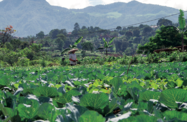Predictions of rosy export figures in 2013 for Indonesia’s palm oil sector offer the country a chance to answer claims that it is not living up to its agricultural potential. However, critics say more innovation and private sector development are needed if self-sufficiency and agribusiness goals are to complement each other.
In January, Fadhil Hasan, executive director of the Indonesian Palm Oil Association (GAPKI), said palm oil exports could increase by as much as 9% this year, as improving global conditions encourage greater demand.
Palm oil inventory levels are between 3m and 4m tonnes, well above the average level of around 1.5m tonnes, Hasan told Reuters news agency. In 2012 GAPKI said Indonesia’s palm oil production would rise 7% in 2013 to 27m tonnes.
Although agriculture contributed around 14.7% to GDP in 2012 and employed around 36.5% of the population, or 112.8m people, critics have said the sector could be improved, particularly in the pivotal crude palm oil (CPO) segment. Some estimates predict that CPO will inject around $80.9m into the national economy between 2010 and 2014.
In October, Carlos Ortiz, head of the rural and retail division of the Brazilian branch of Rabobank International, said Indonesia should look to Brazil for best practices to unleash its full potential.
“Agriculture is certainly a sector that will grow tremendously, as there is a lot of potential [in this country],” said Ortiz, during an annual conference held by Rabobank Indonesia.
Brazil’s system of integrating key agricultural value chains could be replicated by providing companies with incentives to do all the farming, processing and trading of agricultural goods under one incorporated system, which would lower production costs and maximise economies of scale, said Ortiz.
Also in October, a delegation from the US-based Environmental Protection Agency (EPA) said that Indonesian palm oil could yet be included in the US’s renewable fuel programmes, despite past criticism from environmentalists regarding deforestation caused by the crop and the country’s failure to meet EPA standards earlier in 2012.
Indonesia has 6m ha of oil palm plantations and plans another 4m by 2015 to be exclusively dedicated to biofuel production. However, in January 2012 the Southeast Asian palm oil industry failed to meet greenhouse gas savings standards to qualify for the US renewable fuels programme, falling short of a 20% requirement to enter the world’s largest energy market.
Agricultural ambition, however, is equally evident in other sectors of crop production and agribusiness. Indonesia intends to increase rice production from an average of 2.7 tonnes per ha to a minimum of 6 tonnes per ha. Remarking on a budget allocation of Rp10.4trn ($1.06bn) for 2013, H Suswono, the minister of agriculture, said the funds will be used to increase the production of food crops, develop infrastructure and expand food crop research.
Suswono has said unmilled rice output is expected to hit 72.06m tonnes in 2013, up from 68.97m tonnes in 2012; corn output will hit 19.83m tonnes in 2013, compared with 18.96m tonnes in 2012; and soybean production will almost double to 1.5m tonnes from 783,000 tonnes in 2012.
Regardless of the expected bump in production this year, the Organisation for Economic Cooperation and Development (OECD) said in an October report that export taxes and import curbs on farm commodities must be reformed to spur investment in the agriculture sector and improve national food security, rather than continuing to focus on achieving self-sufficiency. In January, Indonesia reduced its export tax on CPO from 9% to 7.5% but announced it would not be reducing it to zero, as Malaysia has done.
“Import protection hinders the competitiveness of the agricultural sector, limiting agricultural productivity growth and increasing food costs for poor consumers, including the majority of farmers, who are net buyers of food staples,” wrote the OECD, recommending that Jakarta increase public funding on agricultural research and development (R&D), improve the reliability of water supplies and develop a long-term strategy for farm restructuring.
In response, domestic critics have accused the international body of unnecessary interference, stating that R&D has long been a cornerstone of agricultural development.
Indeed, Ignacio Pérez Domínguez, an economist and policy analyst at the OECD, told the Science and Development Network, a not-for-profit organisation, that Indonesia was a good example of a developing country that has developed a successful innovation system for agriculture, linking its private and public sectors to boost production.

